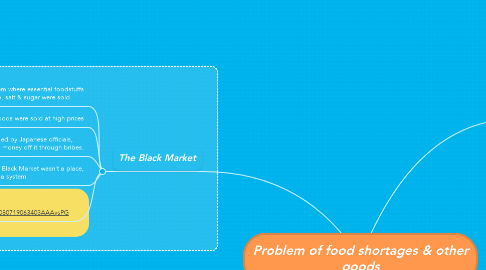Problem of food shortages & other goods
par denise lim

1. The Black Market
1.1. A system where essential foodstuffs like rice, salt & sugar were sold
1.2. All foods were sold at high prices
1.3. Secretly encouraged by Japanese officials, who were making money off it through bribes.
1.4. The Black Market wasn't a place, but a system
1.5. Source:http://answers.yahoo.com/question/index?qid=20080719063403AAAysPG
2. Food Rationing
2.1. first-come-first-serve basis
2.2. Could not get any provisions from shops if one does not have this ration card
2.3. The Japanese issued ration cards
2.3.1. Each adult given a ration of 4.8kg of rice per month(later reduced to 3.6kg) / Each child given 2.4kg
2.3.2. Food ran out quickly with the exception of the wealthy and those who had connections with the Japanese
2.3.3. Substitutes for rice, bread, milk and other foods became regular items on the dining table
2.4. Source:http://ourstory.asia1.com.sg/war/ref/japocc.html
3. Japanese "banana notes"
3.1. Unlimited supply of banana notes
3.2. The "banana notes" were printed on inferior quality paper with no serial number & could be forged easily
3.3. The money was worth so little that the phrase "banana money" came to mean useless money. Some people even went shopping with bags of banana notes. In fact, a used towel could fetch as much as $300 worth of banana notes
3.4. The value of these "banana notes" dropped and led to soaring prices, making life harder
3.5. Source:http://library.thinkquest.org/10414/japan.html
4. The well-being of the people
4.1. Many lived in poverty & suffered from malnutrition and diseases
4.2. Source: History textbook p.g. 115
5. Other goods
5.1. There was shortage of water, electricity, gas, food and other basic essentials. Rubber trees were cut down to grow subsistence crops for the Japanese (mainly tapioca, millet and maize.)
5.2. Source: http://library.thinkquest.org/C005852/economic.htm
5.3. The people of Singapore made their own soap, shoe polish and frying pans. Ropes made from pineapple fibre and paper from pineapple leaves, bamboos or lalang appeared in the market - Adapted from "The Syonan Years, 1942-1945" by Eunice Thio in 'A History of Singapore' by Ernest Chew and Edwin Lee



